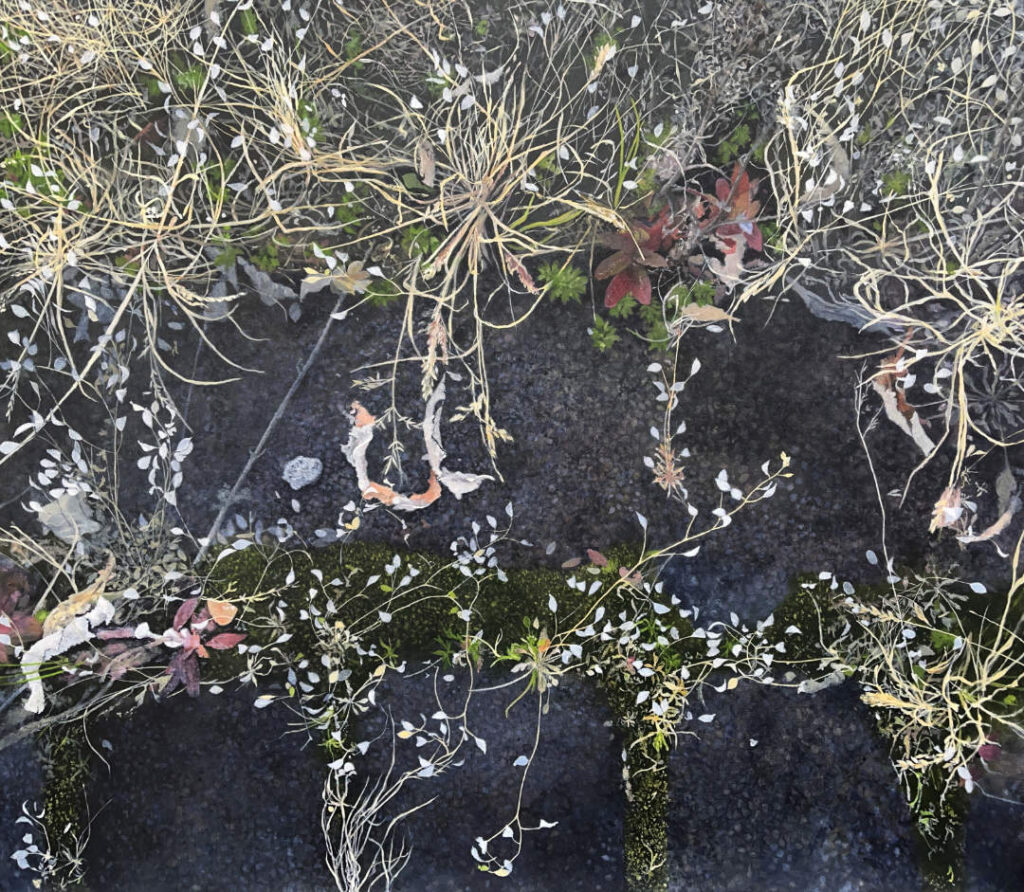
habitat
an exhibition of paintings by Helen Thomas
Mura Ma, 15 Stockport Rd, Marple, Stockport, SK6 6BD
3 – 18 May 2024
Opening times: Thursday, Friday Saturday 11 am – 4.30 pm
or by appointment email hello@murama.co.uk
Gallery website
Preview: Thursday 2 May, 7pm-9pm
“Specificity of time, place and plants are the subject matter for this Wakefield-based artist who is inspired by plants and their locales. Working in response to gardens, countryside and post-industrial edgelands, Helen has become focused on unplanned plants and organisms that grow haphazardly in carparks, on pavements, walls, edges of paths – the margins of our urban environment.
Helen records and maps the minutiae of these plants through her fieldwork, in which she embarks on drawing, painting and note-taking from direct observation.
In the studio, Helen’s process of painting is concurrent with slow looking. The paintings extend an invitation to take time on fringes and fragments of plants caught freeze-frame in the break of a stride, where ribbons of micro-habitats thread through the overlooked and seemingly insignificant.
Working with paint including acrylic, gouache and watercolour either on board, on paper and sometimes on canvas, Helen’s studio practice transforms these records into stunning paintings that elevate these forgotten and overlooked life forms and invite the viewer to regard with wonder.
“Plants and their locale have always been the focus of my work in some way or another. When I first moved into my studio, at The Art House, in the centre of Wakefield in 2016 I felt a sense of disconnection from the edgelands areas, a few of miles out of town, that had previously informed my drawings and paintings.
“Interesting things happen at edges, margins, and in transitory spaces, as they shift through phases of use, vacancy and development. In an attempt to better understand my new environment, I began paying closer attention to what happens where a wall meets the pavement, where public space meets private property and in post and pre-development spaces. Whilst out picking litter one day, I checked a fleeting inclination to uproot a ‘weed’. It’s not uncommon for pavement plants and litter to be associated by their proximity.
As Richard Mabey says in The Unofficial Countryside “They seem, to the unconditioned urban eye, as insignificant and maybe as annoying as a splash of spilt green paint”. As I carefully started to disentangle crisp packets, cans and plastic from leaves, stems and flowers, I began to see these fragile green fringes with fresh eyes. Here, often in improbable conditions, grew plants that had somehow found ways to survive.
Helen not only provokes us to look again, but also to value these edgeland species; “wildflowers can support bees, butterflies & birds; they help trap pollution and they bring colour and softness to the built environment. Once we start to notice and reconsider these plants they can be seen as part of a fascinating wildlife habitat and an opportunity for much-sought connection with nature, on our doorstep, at our feet.
“Might we reconsider the plants, in our day-to-day surroundings, that are often overlooked and dismissed as weeds? Can we consider an alternative to the excessively mowed, trimmed and sprayed ‘landscape maintenance’? I wanted to get in close, to slow down the looking “where the snatched side-long glance is the convention.” (Mabey).
“Fieldwork, which includes drawing, painting and taking notes from direct observation, is a key to my practice. I sketch and paint in corners of car parks, on path edges and in empty plots, often in my hometown of Wakefield. I’m gradually learning to recognise more plant species, however, I still have much to learn about plant identification. Inaccurate notes and misidentification are an accepted part of the process, for example, I have included ‘maybe’ in titles rather than correcting a mistaken plant identity or where I might have misremembered a location. I’m interested in mapping and celebrating the noticing through painting, and extending an invitation to follow my gaze, rather than attempting to authoritatively illustrate.
“In the studio, I paint from printouts selected from the many phone snapshots that I take on daily walks; I also refer to the digital images on my laptop. This is a close but not specifically accurate process of interpretation which involves memory, visual perception and visual interpretation combined with the material qualities of paint and the processes of painting. I sometimes make several paintings from the same reference photo, the composition, proportions and varying from format to format. The painting is slow; in the time frame that it takes to complete a studio painting, the corresponding plant might have completed more than one life cycle.
When I’m painting or sketching on-site I often note the date, location and plant names (If I know them). Through painting and paying attention to the specificity of the details I realised that this ‘could be anywhere’ patch of ground held clues: the way that dandelion grows, those fragments of dry bramble stem, the moss, those seedlings. What, at first glance, might seem to be an image that could be from any town or village in the UK is actually a micro-scape of a particular somewhere.”